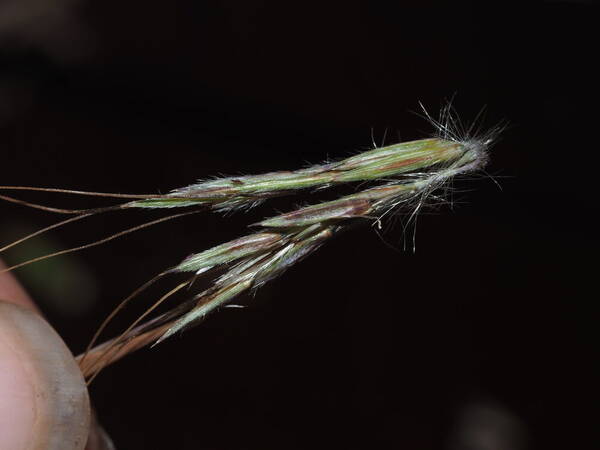Info
Subfamily: Panicoideae
Genus etymology: Hyparrhenia = "male below" [Greek] refering to the male flowers at the base of the raceme
Species etymology: hirta = "hairy" [Latin] refering to the pedicels
Photosynthetic type: C4 (warm season)
Nativity: naturalized - intentional
First recorded in Hawaiʻi: 1962
Map


Inflorescence




Plant


Habit


Spikelets










Landscape


Culm base

Peduncle of inflorescence

Description
Caespitose perennial arising from short underground rhizomes, the basal leaf-sheaths glabrous or very rarely obscurely puberulous; flowering culms wiry, typically 30–60 cm. high (1 m. or more in exceptionally robust plants), standing over a dense leafy tussock 10–20 cm. high. Leaf-blades narrowly linear to conduplicate and filiform, 2–15(–30) cm. long, 1–2(–4) mm. wide, flexuous, glaucous, harshly scaberulous. False panicle typically scanty, up to 30 cm. long, bearing 2–10 raceme-pairs or sometimes more; spatheoles linear-lanceolate, 3–8 cm. long, at length reddish, the peduncles about as long; racemes 2–4 cm. long, 8–13(–16)-awned per pair, white villous, never deflexed; raceme-bases unequal, the upper 2.5–5 mm. long, filiform, glabrous or more often pubescent to hirsute. Homogamous pairs 1 at the base of the lower or both racemes. Sessile spikelet 4–6.5 mm. long, white villous (occasionally the hairs rather sparse); callus 0.5–1.5 mm. long, subacute to acute; awn 10–35 mm. long, puberulous with white hairs 0.1–0.3 mm. long. Pedicelled spikelet white villous, muticous.
(Description source: Clayton, W.D. & Renvoize, S.A. 1982. Flora of Tropical East Africa. Gramineae (Part 3). A.A. Balkema, Rotterdam. 448 pp. )
Tufted, shortly rhizomatous perennial up to 60(–100) cm high. False panicle typically scanty, up to 30 cm long; spatheoles linear-lanceolate, 3–8 cm long, reddish; peduncle about as long as the spatheole, with or without spreading white hairs above. Racemes never deflexed, 2–4 cm long, 8- to 13(–16)-awned per pair; raceme-bases unequal, the upper 2.5–5 mm long, filiform; homogamous spikelet-pairs 1 at the base of the lower or both racemes. Sessile spikelet 4–6.5 mm long, villous; awn 10–35 mm long. Pedicelled spikelet 3–7 mm long, white-villous.
(Description source: Cope, T.A, (1995) Flora Somalia, Vol 4. Royal Botanical Gardens, Kew, London. 312 pp. )
Caespitose perennial arising from short rhizomes; culms up to 60 cm high (up to 1 m in exceptionally robust specimens), wiry, standing above a dense leafy tussock 10–20 cm high. Leaf sheaths compressed and keeled, glabrous or rarely obscurely puberulous; leaf laminas 2–15(30) cm × 1–2(4) mm, narrowly linear to conduplicate and filiform, flexuous, glaucous, harshly scaberulous. False panicle up to 30 cm long, typically scanty with only 2–10 raceme-pairs but sometimes a little fuller with more raceme-pairs; spatheoles 3–8 cm long, linear-lanceolate, at length reddish; peduncles about as long as the spatheoles, glabrous or with white bulbous-based hairs above; racemes 2–4 cm long, 8–13(16)-awned per pair, white-villous, terminally exserted, never deflexed; raceme-bases unequal, the superior 2.5–5 mm long, filiform, glabrous or more usually pubescent to hirsute, with or without a white beard at the foot. Homogamous spikelets similar to the pedicelled, a single pair at the base of the inferior or both racemes. Sessile spikelets 4–6.5 mm long; callus 0.5–1.5 mm long, subacute to acute; inferior glume linear-elliptic, yellowish-green to violet, white-villous but occasionally the hairs rather sparse; awn 10–35 mm long, puberulous with white hairs 0.1–0.3 mm long. Pedicelled spikelets 3–7 mm long, narrowly lanceolate, white-villous, acute and muticous at the apex; callus absent; pedicel-tooth 0.2–1 mm long, subulate.
(Description source: Cope, T.A. (ed.). 2002. Flora Zambesiaca. Volume 10. Part 4. Kew, London. 190 pp. )
Plants perennial; cespitose but with short rhizomes. Culms 30-100 cm. Sheaths glabrous; blades 2-40 cm long, 1-3(4) mm wide. Peduncles 5-10 cm; rames 1-3.5(4) cm, 1 almost sessile, the other with a 5-10 mm base, both with 8-14 heterogamous spikelet pairs. Glumes of all spikelets densely pubescent, hairs to 0.3 mm, white to dark yellow. Sessile spikelets of homogamous pairs 4.9-5.6 mm; sessile spikelets of heterogamous pairs 4-4.5 mm; lemmas awned, awns 1-3.5 cm. Pedicellate spikelets 4.8-6.5 mm. 2n = 30, 44, 45.
(Description source: Barkworth, M.E., Capels, K.M., Long, S. & Piep, M.B. (eds.) 2003. Flora of North America, north of Mexico. Volume 25. Magnoliophyta: Commelinidae (in part): Poaceae, Part 2. Oxford University Press, New York. 783 pp http://floranorthamerica.org/Hyparrhenia_hirta )